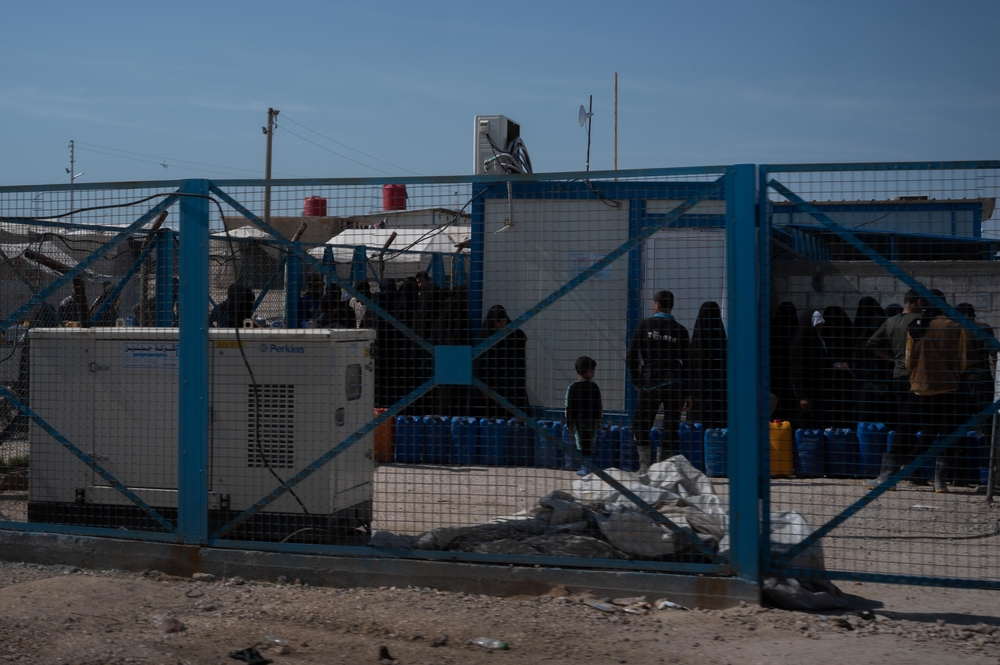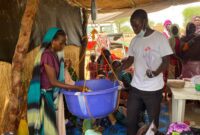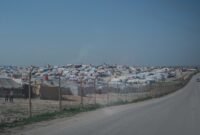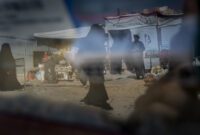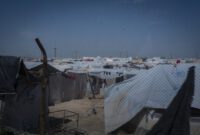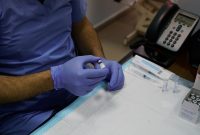No Safety for a Child
Dr. Reza Eshaghian shares experience working as a Medical Team Leader in Al Hol
Vikki who is a nurse, Yasmeen, a translator, and I were standing out in the waiting area of the Doctors Without Borders/Médecins Sans Frontières (MSF) Annex clinic in Al Hol camp, Syria. We were there before the security forces had opened the gate from the Annex. We were staring off quietly for a moment, waiting for the gates to open.
Suddenly, disturbing our silence, a man rushes in, panicked, carrying a limp person in his hands. There’s blood on his coat and distress on his face. Snapped out of our calm, we run and guide him to the appropriate room that has our emergency supplies. We guide the man to place the person on the stretcher. He drops the person and runs out and back to the gate.
Yasmeen and I examine the patient on the stretcher. He’s a child, about 8 years old. He’s wearing jeans, a sweater and sneakers. There is a large depression of the skull at his nose and eyes and a slow trickle of blood from his nose – obvious blunt force trauma. He’s not breathing. There is no pulse.
He’s dead.
There is silence but our minds are racing. What happened?
Vikki looks at me. “Let me find out what happened,” she says, and steps out of the room.
Just as Vikki steps out, panic storms the room. Three women in black flowing niqabs come in, crying out. One is yelling to the boy to wake up. Another is pleading for answers in Arabic. Recognizing Yasmeen’s and my resigned faces, she blurts out crying.
“Yasmeen, can you translate?”
“Yes of course”
“…I’m sorry…He passed away.”
Yasmeen translates.
All three woman start to wail. We stand patiently.
A few moments later, a bit of calm returns.
“May I ask, what happened?”
Yasmeen has some difficulty understanding their Arabic, since it’s not their native language. They explain that he was playing around in the market with other boys. There was a big rock on some sort of wall. The boy reached up for the rock, pulled on it and it then it fell onto him. A man working in the market saw it all, grabbed him and ran to our clinic.
They would like to take the boy back to their tent to clean him the appropriate way for a Muslim burial.
“If that is what they would like, from our side there is no problem,” I respond.
Yasmeen and I place the boy in what we believe is a dignified manner: we straighten his legs and put his arms neatly to the side. We clean up some of the blood and place a sheet over him. We step out of the room to give the family a moment to grieve.
After I step out of the room, I am then told that the authorities will not allow the boy’s body to return to the tent. They will take the body to a different place to be buried. They will not allow anyone from the Annex – not even a member of the boy’s family – to join the body and they will not be allowed to witness the burial. It was a stark reminder; the boy was effectively a prisoner.
I re-enter the room to tell them the restrictions imposed on them by authorities.
“The authorities won’t let you take him back to the tent. They have called the ambulance and he will be taken away. They assured us he will be buried appropriately according to Muslim practice. I’m sorry.”
The one woman stands up and walks right up to me. She starts yelling. Her eyes are on fire: demanding my attention, demanding that I look back her in the eyes and say that again. The translator can’t keep up with everything she’s saying, but it wasn’t needed, the tone of her voice said it all – a justified response.
Another woman interrupts the yelling woman and calms her down. She resigns herself the reality of the situation. She looks at me and speaks with me.
“She wants to let her family see him before he goes.”
“Of course.”
Yasmeen and I step out of the room and head to the gate. Behind the gate, there are about 20 women and a handful of children. It’s quiet. I walk up to the guards with Yasmeen. They are not acting in their usual proud manner, they’re subdued. The death of a child is tragic, even if they are effectively your prisoner. I tell them the situation. They agree to allow some family members in. The ambulance arrives at the same time.
I speak to the driver. “Can you give the family some time to be with the body? They’ll never get to see him again.” He agreed.
Yasmeen and I return to the waiting room and it’s back to its quietness from earlier the day. The occasional woman coming in and out of the room with the boy in it. All the staff have returned to their consultation rooms, even though there are no other patients.
Now we just wait. I pull out my laptop in an attempt to be productive, but just stare at the screen.
***
“They’re ready.” Yasmeen finally says.
I look up. The door is open, and a procession of women come out of the room heading to the gate. The mother comes out, holding her son in her arms. They removed the sheet, and presented his body for everyone to see.
I had not seen a funeral like this, but then again, what would I expect from such a setting where a mother can not decide fully how her son may be laid to rest.
She marches back to the gate. Yasmeen and I follow.
The mother announces, in a loud demanding voice, the arrival of her son. She commands the attention of the space around her. She marches by the closed gate, showing her son to the imprisoned witnesses. The women on the other side of the gate reach their arms out, whispering prayers. The guards keep their gaze down. Everyone obeys – a ritual performed for the first time – an ad hoc funeral. The mother pauses there for a moment. Let all who are there to see her son and what will happen to him. She then carried him to the ambulance.
We hear crying. The women are consoling each other.
About 5 minutes pass.
Then from behind the group of women on the other side of the gate, an elderly woman appears holding hands with a young girl, maybe 6 years old. The guards open the gate and let them in. This is the boy’s grandmother and his sister. They are met with the mother, and together walk to the ambulance. This morning they were all together, and now they have to say goodbye to their grandson, son, brother, rushed in the back of an ambulance.
A few moments later, the grandmother, sister and mother come out of the ambulance. They walk back through the gate.
The ambulance drives away.
The space is heavy, and one by one, the women return to their tents.
***
The next day I spent in the office. At the end of the day, a doctor colleague comes to tell me
“…it happened again today…”
“What do you mean…another child?”
“Yes… this time it was a water truck that hit a 7 year-old boy.”
The Annex camp is not a safe place for a child.
